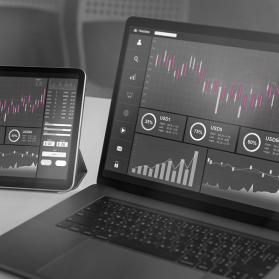By now, the value of data should be known to everyone. Data protection, big data, databases: you hear or read these words almost daily in the news or in trade magazines. Especially for companies in the mobility industry, data is becoming an increasingly important part of the business model. It is collected and gathered, but the use cases for using the data are still unclear in many cases. Companies in the mobility industry in particular are diligently collecting and hoarding infrastructure and movement data, even though they are not yet able to use it profitably. So far, very few know what can be done with the data and exactly what data is needed to be able to generate real added value. Data strategy - the unknown entity.
As part of the Detecon study on Smart Mobility (preview study), we talked to various players in the mobility industry about the collection and utilization of data. What data is needed to shape the mobility of the future? How do you get this necessary data? How do you develop a data strategy? And how is it possible to generate actual benefits for the design of mobility offers from the collected data?
Data is important - but what exactly is it?
What exactly do we mean by data? Data is a group of characters that are combined for the purpose of processing and represent information, i.e., information about facts and processes, on the basis of known or assumed agreements (Gabler Wirtschaftslexikon). In the mobility use case, this includes data about the travelers themselves, the transport infrastructure, the mobility hubs and the means of transport.
Big data approach to collecting data
In discussions with companies in the mobility industry, we were able to gain some interesting insights into the current use of data. For example, more than 50% of these companies follow a Big Data approach when collecting data as the basis for a data strategy. This means that companies are already collecting as much data as possible with an eye to the future, even if value cannot yet be generated with all of it. This statement is also supported by a statistic from 2017, which shows that only 36% of German companies had Big Data solutions in use at that time (Statista).
Nowadays, however, not only a large amount of data is collected. A wide variety of data types are being collected at the same time, which places new demands on systems. Not only must data be able to be integrated quickly in large quantities in order to keep up with the constant change in business cases, but it must also be retrievable just as quickly in a suitable form.
The majority of the companies surveyed from the mobility sector consider the value of data to be high. However, the value of data is currently still underestimated, especially among automotive manufacturers, and there is often no uniform data strategy that forms the basis for data-driven solutions. The handling of data is often not yet clearly regulated, but in most cases it is managed centrally, provided a suitable Big Data environment exists. The enormous importance of data is also reflected in the increase in sales of Big Data solutions in Germany. In 2016, companies generated 5.1 billion euros with Big Data solutions. In 2018, the figure already rose by 1.3 billion euros to 6.4 billion euros (Statista).
Data strategies and data models - the first step to solving the problem?
How can companies solve this problem? How do they manage to identify the most important data and compile it clearly?
Data strategies and data models provide the remedy. A data strategy is a formulated and goal-oriented procedural plan for turning data into added value. The data strategy is derived from the corporate strategy and therefore pays off in the long term in terms of achieving corporate goals. It can thus also be understood as a business plan for profit-oriented data utilization. A data strategy defines timelines and the expected use of resources as well as framework conditions, both technically and in terms of integration into the company.
On the one hand, such a strategy is relevant for companies that do not know how they can participate in the trend toward data use. By creating a data strategy, they succeed in providing a direction and a target picture to work towards.
On the other hand, companies that have been using big data for many years but are now facing a variety of issues and project challenges can also benefit from a data strategy. This procedural plan can significantly reduce the problems that exist with regard to data use in projects and across companies (Data Science Blog).
A so-called meta data model maps the global logical structure of all data of a company and is the basis for the efficient processing of large amounts of data. In this process, all data is presented in a structured manner and put into a tangible and systematic form. This enables the company to maintain an overview of the variety of data (Gabler Wirtschaftslexikon).
A data strategy and an overarching data model are thus necessary to establish a clear goal and a uniform structure for the use of data in the company. This is the only way to identify the most important data that can be used to generate new sales or improve existing services and processes.
Despite the enormous advantages offered by a data strategy, another finding from the survey is that very few companies in the mobility industry have such a clearly defined strategy.
Thriving data future
In 2016, global revenue from Big Data solutions was still $27.3 billion. 10 years later, in 2026, revenue from Big Data solutions is forecast to reach $92.2 billion (Statista). Business is booming. Not only is revenue increasing, but the volume of digital data generated worldwide each year is also growing enormously. From 2018 to 2025, data volumes are expected to grow by approximately 500% from 33 zettabytes to 175 zettabytes (Statista). By the way, a zettabyte is a 1 with 21 zeros. More and more data will be collected and needed through further sensor technology, digital services and artificial intelligence.
Future algorithms and new technologies must be able to handle this mass in order to quickly use new data and data types in calculations. A uniform data model and the use of a data strategy must separate "the wheat from the chaff". Once the relevant data has been identified and can be focused on, most companies in the mobility industry assume that they can handle their collected data on their own. Even among the automotive manufacturers, who are currently not yet driving a Big Data approach, a targeted search for the relevant data is to be carried out in the future.
A central use case for the mobility of the future is intermodal mobility and dynamic route guidance. It is no longer a question of: How do you get from A to B? Rather, it's about how to get from A to B to C using the fastest, most efficient, and least expensive selection of various modes of transportation. There is no ONE perfect solution. It's the overall system that has to work, and it doesn't just consist of public transport. There are also sharing services, journeys by minibus, journeys by car or bicycle and journeys on foot. In order to realize this overall system, a large amount of data is needed and must be accessible. A selection of information sources include:
- Live movement data from as many road users as possible.
- Incidents such as train cancellations, construction work, accidents, etc.
- Historical traffic data that can be used to forecast traffic or people flows
- Demographic data (e.g. population development, mortality rate, birth rate, population migration)
The data sources may be different for each company in the mobility industry. The relevant data must be identified in order to be able to realize the use case under consideration and to develop a data strategy. To this end, individual companies must open up more and more and strive for a cooperative approach, which in turn can lead to greater complexity due to overarching data and role models. Established data marketplaces that provide clear structures for the exchange and joint use of shared data can help.
One thing is certain: the haystack of data will not get any smaller in the future. This applies not least to players in the mobility industry. Increasing networking, IoT and artificial intelligence will cause the data mountain to grow continuously. This makes it all the more important to deal confidently with the masses of data and to develop a data strategy. Companies will benefit from an open attitude towards new methods and perspectives on their journey towards data-driven business processes and models.
Identifying the right data
Detecon has developed a process model in which a structured process is used to answer the question of the important data in the company. Together with the clients in the mobility industry, company-specific target images can be worked out, associated use cases developed, and the relevant data sources for cost optimization and/or generation of new business identified. A combination of methods from different disciplines is used for this purpose.
Click here to download the German-language discussion paper
Smart Mobility - Data and Data Sharing as Enablers for Smart Ecosystems






